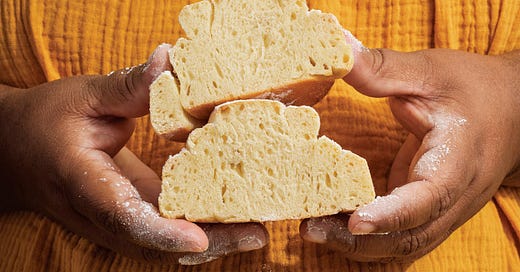This installment of the California Breakfast series is a sneak peak into my upcoming roundup of fall cookbooks by California authors. It comes from one of the most exciting books of the season, Illyanna Maisonet’s Diasporican—A Puerto Rican Cookbook (Ten Speed Press), which comes out next week. In the book, Illyanna shares a lovely essay about the evolution of mallorcas, a traditional pastry often eaten for breakfast. They’re the perfect way to warm up your kitchen (and your mood!) on these chilly fall mornings. I’ll let Illyanna’s headnote speak for itself:
Mallorcas
Makes 8 to 12 mallorcas
When I preheat my cast-iron comal and slip a pat of butter onto the surface, I can’t help but remember a moment when I’d just gotten home from New Orleans. At an artisanal bakery there, I’d purchased a mallorca, a sweet spiral bun made by a baker from Puerto Rico, who was following a centuries-old formula that can be traced back to a tiny island off the coast of Spain. After I removed the pastry from my backpack, where I’d kept it safe and unsquashed on the two thousand-plus-mile journey, I sliced it in half and set the halves cut-side down on the griddle. I then made a sandwich like the ones often found in Puerto Rico, with some crispy bacon and melted American cheese, a decadent treat made even more so by the traditional snowfall of confectioners’ sugar that I dusted over the top. At home in California, every time that I repeat this ritual, I recognize that the mallorcas’ journey isn’t over yet.
10 tablespoons unsalted butter, at room temperature
1 cup warm (about 120°F) water
1 teaspoon dry yeast
1 teaspoon granulated sugar, plus ½ cup
1 cup warm (about 120°F) milk
1 teaspoon vanilla extract
3 eggs, beaten
6 cups all-purpose flour
1 teaspoon kosher salt
1 cup confectioners’ sugar
Preheat the oven to 350°F.
In a small pot over low heat, melt 4 tablespoons of the butter. Set aside.
In a small bowl, combine the water, yeast, and 1 teaspoon granulated sugar. Give it a little mix and set aside for 5 minutes, or until the top of the liquid looks foamy. In another small bowl, combine the milk, melted butter, vanilla, and eggs and stir to incorporate.
In a stand mixer fitted with the paddle attachment (or in a large bowl with a wooden spoon), thoroughly combine the flour, salt, and remaining ½ cup granulated sugar. Add the yeast-water and one-third of the egg mixture and mix on medium speed for 10 minutes, or until the dough starts to make a slapping sound. Add the remaining egg mixture, a bit at a time, and blend together; you want to make sure the flour is absorbing all the liquid before adding more, but you also don’t want to add too much liquid. Once the dough starts to tighten and it becomes too much work for the mixer (or you), grab a plastic bench scraper and start to knead the dough. You need to mix only until all the flour is fully incorporated; the dough will be tacky. Cover with plastic wrap and let rest in a warm place for 1 to 2 hours.
Smear the bottom of a baking sheet with 1 tablespoon butter, oil a large bowl, and flour a work surface.
Scrape the dough onto the prepared surface. With the bench scraper, knead and fold the dough for 5 to 7 minutes, or until it’s no longer tacky. It will be pretty moist and absorb the flour on the bench scraper. If you need more flour, it’s fine to add a handful at a time. Continue to work the dough until it’s soft and supple. Place the dough in the prepared bowl and turn it to lightly coat. Cover the bowl with plastic wrap and let rest in a warm place for 30 minutes.
Clean your work surface and then re-flour. Place the dough onto the prepared surface. Flour a rolling pin and roll out the dough into an amorphous rectangle, about ¼ inch thick. With the bench scraper, cut a 1-inch strip off the edge of the dough. With both hands, roll the strip against the work surface to create a cylindrical rope. Arrange that rope into a snail-like coil, tucking the end under the coil. Scoop up the coiled mallorca with the scraper and place on the prepared baking sheet. Repeat with the rest of the dough.
In a small pot over low heat, melt the remaining 5 tablespoons butter. With a pastry brush, brush 2 tablespoons butter over the mallorcas. Cover the baking sheet with plastic wrap and let rest in a warm place for 30 minutes.
Bake for 15 to 30 minutes, or until the mallorcas are firm and sliiiightly brown. Place the baking sheet on a wire rack, brush the mallorcas with the remaining 3 tablespoons melted butter, and let cool completely.
Dust the mallorcas with the confectioners’ sugar all over—douse ’em!—before serving.
Note: Mallorcas can be frozen; after you shape the dough into the snail-like coils, instead of baking, just put them in freezer storage containers and they’ll keep for up to 6 months. Bake from frozen on a baking sheet in a 350°F oven for 20 to 30 minutes. You can also use mallorcas to take the place of buns for hamburgers and in bread in the iconic ham-and-cheese breakfast sandwich.
Reprinted with permission from Diasporican: A Puerto Rican Cookbook by Illyanna Maisonet copyright ©2022. Puerto Rico location photographs by Erika P. Rodriguez. California location and food photographs copyright © 2022 by Dan Liberti. Published by Ten Speed Press, an imprint of Penguin Random House.




